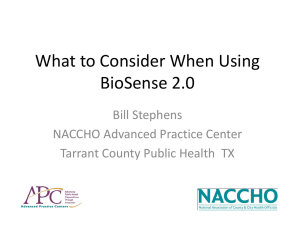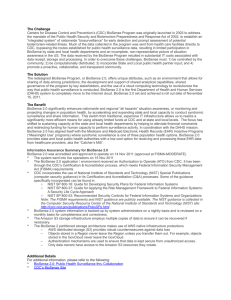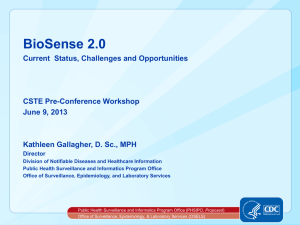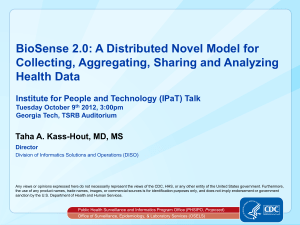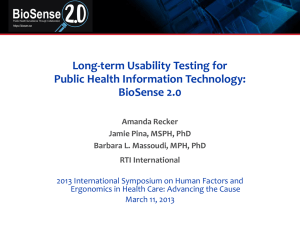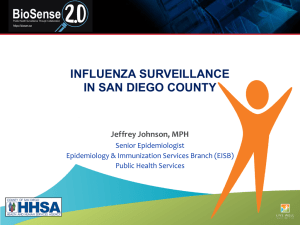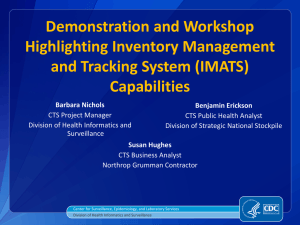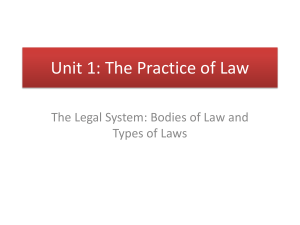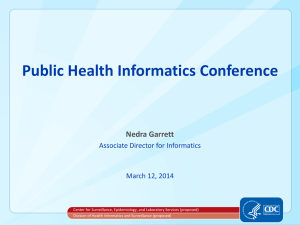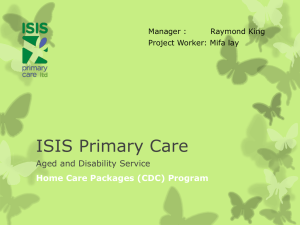Presentation Slides
advertisement
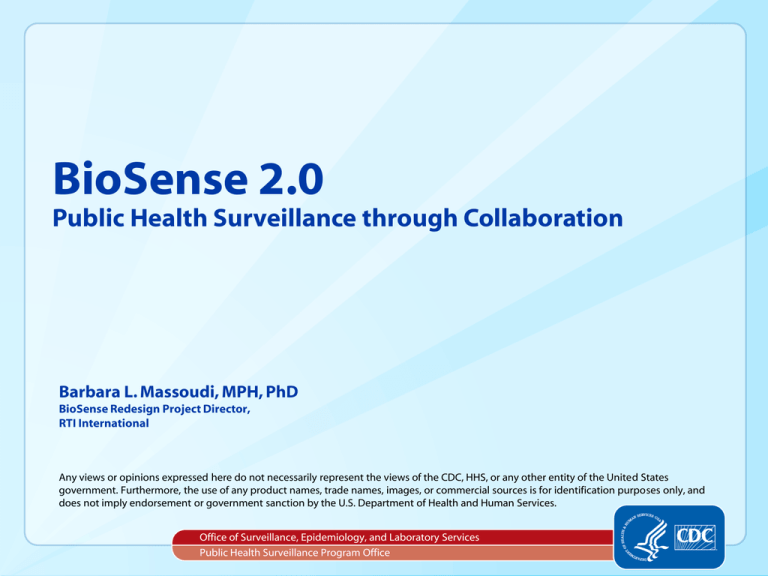
BioSense 2.0 Public Health Surveillance through Collaboration Barbara L. Massoudi, MPH, PhD BioSense Redesign Project Director, RTI International Any views or opinions expressed here do not necessarily represent the views of the CDC, HHS, or any other entity of the United States government. Furthermore, the use of any product names, trade names, images, or commercial sources is for identification purposes only, and does not imply endorsement or government sanction by the U.S. Department of Health and Human Services. Office of Surveillance, Epidemiology, and Laboratory Services Public Health Surveillance Program Office History of BioSense 2002 Mandated in the Public Health Security and Bioterrorism (BT) Preparedness and Response Act of 2002 Nationwide “integrated system” for early detection and assessment of potential BT-related illness 2003 Funding provided by Congress to CDC Development of BioSense infrastructure started, initial focus on: • VA and DoD • Direct reporting to CDC of detailed clinical data by civilian hospitals (initiated in 2004) 2006 Began soliciting more limited data from health departments that had already established automated systems for ED-based syndromic surveillance • By 2007, 8 state/local HDs connected Epidemiologic Objectives Syndromic Surveillance & BioSense Early event detection Rapid event characterization (regardless of how detected) Ongoing & timely monitoring over course of event Situation Awareness Value Examples 2011 Japan Earthquake/Tsunami Cluster of Visits for Heat-Related Illness in Texas 2010 Dengue surveillance - Florida Gulf Oil Spill Maryland anti-infective pharmaceutical surveillance 2009 H1N1 event and Distribute BioSense 1.0 Environment Jurisdiction Hospital Public-Access Recommendations from Prior Evaluations (GAO, US Senate, ASTHO, CSTE, BioSense Evaluation Project) Strengthen state and local public health engagement Enhance state/local HD syndromic surveillance capacity Increase participation of state/local HD syndromic surveillance systems (improve coverage) Share data with HDs from hospitals reporting directly to CDC Share governance Leverage investments in EHRs GAO, 2008: Adopt an “open, distributed computing model” Improve utility of the data and data sources Preparedness role: Greater “all hazards” emphasis Expand uses for broader spectrum of PH concerns BioSense 2.0: Approach Shift from a need-to-know to a need-to-share and co-create “User-Centered” design Partners engaged in every step of the redesign Low barrier to participation for HDs and their providers • HDs fully control “their data” at the level of granularity they are authorized • Support expansions in SS prompted by Meaningful Use (MUse) More options for data sharing • HDs are able to share data directly with other jurisdictions and CDC Alignment with ONC and MUse Agreed upon core SS data elements (CDC/ISDS/ONC collaboration) Enhanced partnerships States (ELC): MUse SS adoption, building capacity, joining BioSense 2.0 Collaborations with associations (ASTHO, CSTE, NACCHO) and ISDS Simple and unobtrusive technology option Cloud technology; distributed, easy to adopt, cost-effective, and secure The Cloud: A Scalable Solution BioSense 2.0: Timeline June-October 2011: Governance, Cloud, and Recruitment Established an interim S&L governance structure Identified and procured Amazon as the Cloud vendor Recruitment in coordination with ASTHO, NACCHO, CDC, and ISDS (67 jurisdictions) November 2011: Open for Business S&L HDs can initiate or expand their syndromic surveillance systems under the MUse program for their own jurisdiction Stakeholders can begin collaborating among themselves and CDC in the new environment governed by data use agreements By April 2012: Retire BioSense 1.0 Followed EPLC process (internal to OSELS and the CDC enterprise) BioSense 2.0: Environment BioSense 2.0 Environment Shared Spaces Jurisdiction Hospital Public-Access BioSense 2.0: Environment Four primary services Catcher’s Mitt • Provides for securely receiving (multiple channels), storing, and processing high volumes of data for jurisdictions at no cost to them Data Conversion • Can receive all data forms and formats, including HL7 or CDA, and convert them to any format an individual health department uses Analytics • Compatible environment for the users’ requested analytic tools, such as: SAS and R statistical packages, ESSENCE, etc Collaboration • Allows for ad hoc or continual data sharing among jurisdictions based on data use agreements initiated by the jurisdiction and signed with ASTHO Application Home Page Shared Space A “View” consists of a map, timeline and metadata • Save View for viewing later or sharing • Data can be filtered by demo, sources • Statistical anomaly detection tools • A view can be annotated with notes that are saved for future use and for sharing • The View can be shared within a jurisdiction or other BioSense users (who have similar permissions) • Export View as: .csv, .html, .png, .ppt, .pdf • Self-defined alerts, based on frequency, statistics, etc. sent to email or phone data.biosen.se Linux virtual machine Apache PHINMS VPN Mirth secure FTP NwHIN (Direct Project, Connect, etc. credentials, metadata BioSense 2.0: Recruitment Recruitment is lead by CSTE and coordinated with ASTHO, NACCHO and ISDS First Tier • Jurisdictions that have explicitly communicated their interest • 26: 16 States, 3 Counties, and 7 Cities Second Tier • Jurisdictions with either mature capacity or high value with moderate interest • 35: 29 States (including DC), 5 Counties, and 1 City Third Tier • Jurisdictions who haven’t expressed interest at this time • 6: 6 States [LA, CA, NJ, TX, AL, and RI] BioSense 2.0: Technical Assistance Assist jurisdictions in joining the environment is part of the redesign contract Direct program and application TA Challenge Grants administered by the redesign contract and coordinated with the associations • FY 2012: 10 jurisdictions at $20K each Technology and science innovation prizes administered by the redesign contract and coordinated with ISDS and academic partners Thank You! BioSense 2.0 http://biosenseredesign.org info@biosen.se Any views or opinions expressed here do not necessarily represent the views of the CDC, HHS, or any other entity of the United States government. Furthermore, the use of any product names, trade names, images, or commercial sources is for identification purposes only, and does not imply endorsement or government sanction by the U.S. Department of Health and Human Services.
